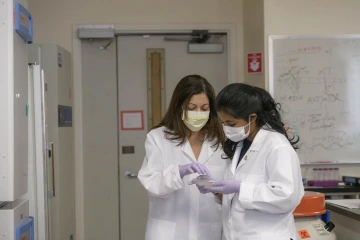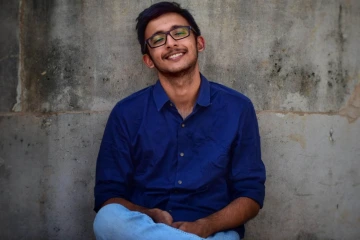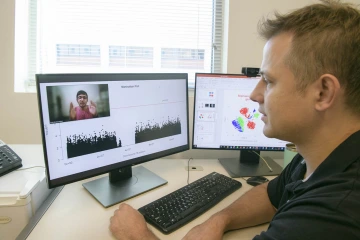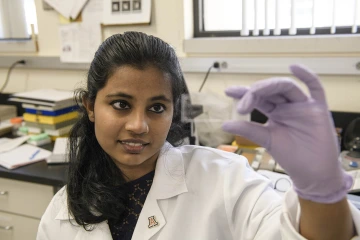International Research Internships Open New Doors
Students in the Health Sciences International dual-degree program gain firsthand experience as program welcomes first research interns.
Half of the world’s population does not receive necessary health services, the World Health Organization and World Bank report. Addressing this challenge begins with educating and training a new generation of international medical professionals who will have opportunities to conduct research and provide care in their home countries.
The University of Arizona Health Sciences International was established to provide that training through advanced educational programs around the world. In fall 2020, UArizona Health Sciences International launched a dual-degree master’s program in cellular and molecular medicine with the UArizona College of Medicine – Tucson and Amrita Vishwa Vidyapeetham University in India.

Meenu Priya (right) is the first student to participate in an in-person internship through Health Sciences International. She spent the fall semester working in the lab of Yana Zavros, PhD, (left) using patient-derived tissue to create organoid models in the study of pancreatic cancer.
“Health Sciences International brings new perspectives to research,” said Carol Gregorio, PhD, assistant vice provost of Health Science International and BIO5 Institute member. “It is important for us to get Amrita University students from the cellular and molecular medicine dual-degree program involved in biomedical research. Their experiences are noteworthy because the issues they face with human health can sometimes be much different than ours."
Now in its second year, the dual-degree program has approximately 60 students, including the first two to participate in a research internship. This semester, one of the students conducted his internship remotely from India, while the other traveled to Tucson for her three-month program.
Fulfilling an educational dream
Meenu Priya has a strong background in microbiology. She received her bachelor’s degree in microbiology from the Amrita School of Biotechnology and was pursuing a master’s when, in her second year of the program, Amrita and UArizona Health Sciences formalized their partnership. The agreement opened new doors for Priya.
“Earning a degree from a U.S. university was always a dream of mine,” Priya said. “It was a wonderful opportunity for me.”

Kartik Moolraj Dattani credits his mentor, Jared Churko, PhD, for letting him try new things and make his own mistakes as he develops a more complete understanding of bioinformatics.
Priya soon became fascinated by what she was learning in a pathophysiology class offered as an elective through the dual-degree program. The class was taught by Yana Zavros, PhD, a professor of cellular and molecular medicine at the College of Medicine – Tucson.
In discussions with Priya, Dr. Zavros shared information about her lab, which studies the mechanisms that drive gastric epithelial regeneration, and gastric and pancreatic cancer using a novel organoid system. Her lab has developed patient-derived gastric and pancreatic cancer organoids that are used in personalized drug screens to predict individual therapy response.
Priya was intrigued and decided to pursue a three-month internship with Dr. Zavros through Health Sciences International.
“Working in Dr. Zavros’ lab and focusing on cell biology has helped me to translate my theoretical knowledge into practical knowledge,” Priya said. “My long-term goal now is to target stem cells within the tumor microenvironment of different types of cancers.”
Short-term solution, long-term opportunity
Kartik Moolraj Dattani was excited to gain practical experience after graduating with a bachelor’s degree in biotechnology from Amrita. The pandemic interrupted his plans, but also opened the door for him to explore the cellular and molecular medicine dual-degree program.
Once enrolled, Dattani learned about the various research labs at the College of Medicine – Tucson. He was immediately drawn to the lab of Jared Churko, PhD, an assistant professor of cellular and molecular medicine and member of the BIO5 Institute. Dr. Churko’s lab seeks to understand the mechanisms leading to heart disease by combining single cell transcriptomics, systems biology, stem cell biology, genetic engineering and bioinformatics.

Dr. Churko had weekly Zoom meetings with Dattani (pictured on monitor) to discuss his remote research project. Dattani hopes to continue his research internship in person during the spring semester.
Dattani wanted to pursue an internship with Dr. Churko, but there was one problem: he wouldn’t be able to travel to the U.S. for the fall semester. Fortunately for Dattani, he and Dr. Churko were able to craft a plan to make a remote research collaboration mutually beneficial.
“Wet lab work has to be performed within the lab,” Dr. Churko said. “However, bioinformatic work can be performed remotely with only a computer. We share the data digitally.”
Despite a half-day difference in time, Dr. Churko and Dattani meet weekly via Zoom to discuss the work. Dattani says he is planning to continue the collaboration with Dr. Churko in the spring, and he is hoping to do so in person so that he can get the full internship experience.
“This research has helped me to try a lot of different things in the work we are doing,” Dattani said. “It is great to have that feeling that I am contributing to the lab, but I am very much looking forward to actually being in the lab.”
International research internships provide unique opportunities for students to be involved in research projects and graduate education in the U.S.
“I don’t want this to be a short-term investment, for our lab or for Kartik,” Dr. Churko added. “He has really taken the initiative and that has made this virtual internship work. I’m looking forward to seeing him in the lab and seeing how much more he can grow scientifically.”
Creating independent thinkers
Dr. Zavros walked into her lab one morning and observed what she had been waiting all semester to see: Priya was already there running her own experiment.
According to Dr. Zavros, Priya, like most new interns, was initially hesitant, if not shy, about the hands-on experience in the lab.

Priya would like to return to the UArizona College of Medicine – Tucson next year to pursue a doctorate, which would allow her to continue her collaborations with Dr. Zavros.
“These experiences are about gaining the confidence to think independently,” Dr. Zavros said. “Seeing a student comfortable enough to be in the lab, set up an experiment, conduct the experiment and then analyze the data on their own – that's what I want to see as a mentor.”
Priya completed her internship in November and traveled home to India, but she hopes to return to UArizona Health Sciences to pursue her doctorate next year. By then, Dr. Gregorio anticipates being able to host 10 international students for summer research internships in Tucson, with plans to grow even more in the following years.
“These research internships provide unique opportunities for students to be involved in research projects and graduate education in the U.S.,” Dr. Gregorio said. “It opens doors for them because it makes them much more competitive globally.”

